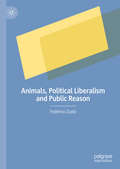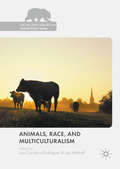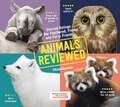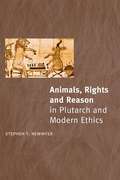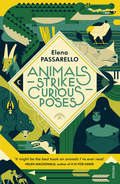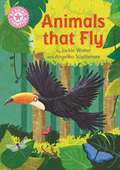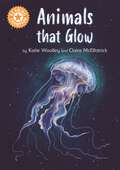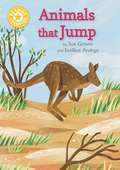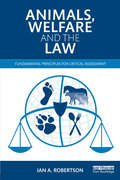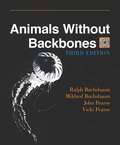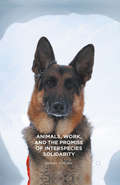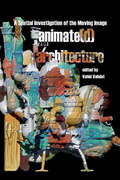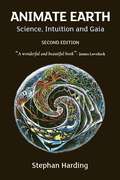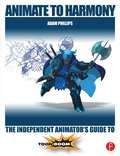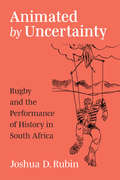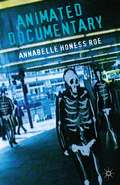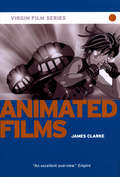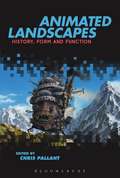- Table View
- List View
Animals, Political Liberalism and Public Reason
by Federico ZuoloThis book explores the problem of disagreement concerning the treatment of animals in a liberal society. Current laws include an unprecedented concern for animal welfare, yet disagreement remains pervasive. This issue has so far been neglected both in political philosophy and animal ethics. Although starting from disagreement has been the hallmark of many politically liberal theories, none have been devoted to the treatment of animals, and conversely, most theories in animal ethics do not take the disagreement on this issue seriously. Bridging this divide with a change of perspective, Zuolo argues that we should begin from the disagreement on the moral status of animals and the treatment we owe them. Reconstructing the epistemic nature of disagreement about animals, Zuolo proposes a novel form of public justification to find principles acceptable to all. By setting out a unified framework which honours the liberal principles of respect for diversity, a robust liberal political theory capable of dealing with diverse forms of disagreement, and even some forms of radical dissent, is achieved.
Animals, Race, and Multiculturalism (The Palgrave Macmillan Animal Ethics Series)
by Luís Cordeiro-Rodrigues Les MitchellThis book focuses on multiculturalism, racism and the interests of nonhuman animals. Each are, in their own right, rapidly growing and controversial fields of enquiry, but how do multiculturalism and racism intersect with the debate concerning animals and their interests? This a deceptively simple question but on that is becoming ever more pressing as we examine our societal practices in a pluralistic world. Collating the work of a diverse group of academics from across the world, the book includes writing on a wide range of subjects and addressing contemporary issues in this critical arena. Subjects covered include multiculturalism, group rights and the limits of tolerance; ethnocentrism and animals; racism and discrimination and non-Western alternatives to animal rights and welfare. The book will be of interest to researchers, lecturers and advanced students as well as range of social justice organisations, government institutions, animal activist organisations and environmental groups.
Animals Reviewed: Starred Ratings of Our Feathered, Finned, and Furry Friends
by Association of Zoos and AquariumsZookeepers hilariously review the animals in their keep—from the anxious aardvark to the zealous zebra shark and every animal in between.
Animals, Rights and Reason in Plutarch and Modern Ethics
by Stephen T. NewmyerThis groundbreaking volume explores Plutarch's unique survival in the argument that animals are rational and sentient, and that we, as humans, must take notice of their interests. Exploring Plutarch's three animal-related treatises, as well as passages from his ethical treatises, Stephen Newmyer examines arguments that, strikingly, foreshadow those found in the works of such prominent animal rights philosophers as Peter Singer and Tom Regan. Unique in viewing Plutarch’s opinions not only in the context of ancient philosophical and ethical through, but also in its place in the history of animal rights speculation, Animals Rights and Reasons points out how remarkably Plutarch differs from such anti-animal thinkers as the Stoics. Classicists, philosophers, animal-welfare students and interested readers will all find this book an invaluable and informative addition to their reading.
Animals, Rights and Reason in Plutarch and Modern Ethics
by Stephen T. NewmyerThis groundbreaking volume explores Plutarch's unique survival in the argument that animals are rational and sentient, and that we, as humans, must take notice of their interests. Exploring Plutarch's three animal-related treatises, as well as passages from his ethical treatises, Stephen Newmyer examines arguments that, strikingly, foreshadow those found in the works of such prominent animal rights philosophers as Peter Singer and Tom Regan. Unique in viewing Plutarch’s opinions not only in the context of ancient philosophical and ethical through, but also in its place in the history of animal rights speculation, Animals Rights and Reasons points out how remarkably Plutarch differs from such anti-animal thinkers as the Stoics. Classicists, philosophers, animal-welfare students and interested readers will all find this book an invaluable and informative addition to their reading.
Animals Strike Curious Poses
by Elena PassarelloBeginning with Yuka, a 39,000-year-old mummified woolly mammoth recently found in the Siberian permafrost, each of the sixteen essays in Animals Strike Curious Poses investigates a different famous animal named and immortalised by humans. Here are the starling that inspired Mozart with its song, Darwin’s tortoise Harriet, and in an extraordinary essay, Jumbo the elephant (and how they tried to electrocute him). Modelled loosely on a medieval bestiary, these witty , playful, provocative essays traverse history, myth, science and more, introducing a stunning new writer to British readers.
Animals that Glow
by Katie Woolley and Claire McElfatrickThis book is part of Reading Champion, a series carefully linked to book bands to encourage independent reading skills, developed with UCL Institute of Education (IOE) Animals that Glow is a non-fiction text reporting on animals that glow to attract prey, protect themselves or communicate. The simple sentence structure offers readers the opportunity for an independent reading experience with the support of the illustrations. Reading Champion offers independent reading books for children to practise and reinforce their developing reading skills. This early non-fiction text is accompanied by engaging artwork and a reading activity. Each book has been carefully graded so that it can be matched to a child's reading ability, encouraging reading for pleasure.
Animals that Jump: Independent Reading Yellow 3 Non-fiction (Reading Champion #515)
by Sue GravesNo synopsis available.
Animals, Welfare and the Law: Fundamental Principles for Critical Assessment
by Ian A. RobertsonIn this objective, practical and authoritative introductory text the author reveals how the fundamental principles of the human-animal relationship drive the development of animal law. The book explains the criteria by which the lawful use of animals is determined, and how these criteria impact evolving standards of animal protection and define the responsibilities of people in their interactions with animals. The author identifies 29 key principles which constitute the core knowledge necessary for people involved in debating, assessing, and guiding the evolution of society’s national and international rulebook of animal welfare law. The book also considers animal welfare and law in the context of a global market through discussion of common issues such as climate change, biosecurity, food safety and food supply. Based on successful law courses run by the author and his own expertise as an animal law lecturer, prosecutor and specialist legal adviser, the book combines insights from science, ethics and law to provide an essential understanding of what informs society and the law with regards to animals and their welfare.
Animals, Welfare and the Law: Fundamental Principles for Critical Assessment
by Ian A. RobertsonIn this objective, practical and authoritative introductory text the author reveals how the fundamental principles of the human-animal relationship drive the development of animal law. The book explains the criteria by which the lawful use of animals is determined, and how these criteria impact evolving standards of animal protection and define the responsibilities of people in their interactions with animals. The author identifies 29 key principles which constitute the core knowledge necessary for people involved in debating, assessing, and guiding the evolution of society’s national and international rulebook of animal welfare law. The book also considers animal welfare and law in the context of a global market through discussion of common issues such as climate change, biosecurity, food safety and food supply. Based on successful law courses run by the author and his own expertise as an animal law lecturer, prosecutor and specialist legal adviser, the book combines insights from science, ethics and law to provide an essential understanding of what informs society and the law with regards to animals and their welfare.
Animals Without Backbones: An Introduction to the Invertebrates (New Plan Texts at the University of Chicago)
by Ralph Buchsbaum Mildred Buchsbaum John Pearse Vicki PearseAnimals Without Backbones has been considered a classic among biology textbooks since it was first published to great acclaim in 1938. It was the first biology textbook ever reviewed by Time and was also featured with illustrations in Life. Harvard, Stanford, the University of Chicago, and more than eighty other colleges and universities adopted it for use in courses. Since then, its clear explanations and ample illustrations have continued to introduce hundreds of thousands of students and general readers around the world to jellyfishes, corals, flatworms, squids, starfishes, spiders, grasshoppers, and the other invertebrates that make up ninety-seven percent of the animal kingdom. This new edition has been completely rewritten and redesigned, but it retains the same clarity and careful scholarship that have earned this book its continuing readership for half a century. It is even more lavishly illustrated than earlier editions, incorporating many new drawings and photographs. Informative, concise legends that form an integral part of the text accompany the illustrations. The text has been updated to include findings from recent research. Eschewing pure morphology, the authors use each group of animals to introduce one or more biological principles. In recent decades, courses and texts on invertebrate zoology at many universities have been available only for advanced biology majors specializing in this area. The Third Edition of Animals Without Backbones remains an ideal introduction to invertebrates for lower-level biology majors, nonmajors, students in paleontology and other related fields, junior college and advanced high school students, and the general reader who pursues the rewarding study of the natural world.
Animals Without Backbones: An Introduction to the Invertebrates (New Plan Texts at the University of Chicago)
by Ralph Buchsbaum Mildred Buchsbaum John Pearse Vicki PearseAnimals Without Backbones has been considered a classic among biology textbooks since it was first published to great acclaim in 1938. It was the first biology textbook ever reviewed by Time and was also featured with illustrations in Life. Harvard, Stanford, the University of Chicago, and more than eighty other colleges and universities adopted it for use in courses. Since then, its clear explanations and ample illustrations have continued to introduce hundreds of thousands of students and general readers around the world to jellyfishes, corals, flatworms, squids, starfishes, spiders, grasshoppers, and the other invertebrates that make up ninety-seven percent of the animal kingdom. This new edition has been completely rewritten and redesigned, but it retains the same clarity and careful scholarship that have earned this book its continuing readership for half a century. It is even more lavishly illustrated than earlier editions, incorporating many new drawings and photographs. Informative, concise legends that form an integral part of the text accompany the illustrations. The text has been updated to include findings from recent research. Eschewing pure morphology, the authors use each group of animals to introduce one or more biological principles. In recent decades, courses and texts on invertebrate zoology at many universities have been available only for advanced biology majors specializing in this area. The Third Edition of Animals Without Backbones remains an ideal introduction to invertebrates for lower-level biology majors, nonmajors, students in paleontology and other related fields, junior college and advanced high school students, and the general reader who pursues the rewarding study of the natural world.
Animals Without Backbones: An Introduction to the Invertebrates (New Plan Texts at the University of Chicago)
by Ralph Buchsbaum Mildred Buchsbaum John Pearse Vicki PearseAnimals Without Backbones has been considered a classic among biology textbooks since it was first published to great acclaim in 1938. It was the first biology textbook ever reviewed by Time and was also featured with illustrations in Life. Harvard, Stanford, the University of Chicago, and more than eighty other colleges and universities adopted it for use in courses. Since then, its clear explanations and ample illustrations have continued to introduce hundreds of thousands of students and general readers around the world to jellyfishes, corals, flatworms, squids, starfishes, spiders, grasshoppers, and the other invertebrates that make up ninety-seven percent of the animal kingdom. This new edition has been completely rewritten and redesigned, but it retains the same clarity and careful scholarship that have earned this book its continuing readership for half a century. It is even more lavishly illustrated than earlier editions, incorporating many new drawings and photographs. Informative, concise legends that form an integral part of the text accompany the illustrations. The text has been updated to include findings from recent research. Eschewing pure morphology, the authors use each group of animals to introduce one or more biological principles. In recent decades, courses and texts on invertebrate zoology at many universities have been available only for advanced biology majors specializing in this area. The Third Edition of Animals Without Backbones remains an ideal introduction to invertebrates for lower-level biology majors, nonmajors, students in paleontology and other related fields, junior college and advanced high school students, and the general reader who pursues the rewarding study of the natural world.
Animals Without Backbones: An Introduction to the Invertebrates (New Plan Texts at the University of Chicago)
by Ralph Buchsbaum Mildred Buchsbaum John Pearse Vicki PearseAnimals Without Backbones has been considered a classic among biology textbooks since it was first published to great acclaim in 1938. It was the first biology textbook ever reviewed by Time and was also featured with illustrations in Life. Harvard, Stanford, the University of Chicago, and more than eighty other colleges and universities adopted it for use in courses. Since then, its clear explanations and ample illustrations have continued to introduce hundreds of thousands of students and general readers around the world to jellyfishes, corals, flatworms, squids, starfishes, spiders, grasshoppers, and the other invertebrates that make up ninety-seven percent of the animal kingdom. This new edition has been completely rewritten and redesigned, but it retains the same clarity and careful scholarship that have earned this book its continuing readership for half a century. It is even more lavishly illustrated than earlier editions, incorporating many new drawings and photographs. Informative, concise legends that form an integral part of the text accompany the illustrations. The text has been updated to include findings from recent research. Eschewing pure morphology, the authors use each group of animals to introduce one or more biological principles. In recent decades, courses and texts on invertebrate zoology at many universities have been available only for advanced biology majors specializing in this area. The Third Edition of Animals Without Backbones remains an ideal introduction to invertebrates for lower-level biology majors, nonmajors, students in paleontology and other related fields, junior college and advanced high school students, and the general reader who pursues the rewarding study of the natural world.
Animals, Work, and the Promise of Interspecies Solidarity
by Kendra CoulterIn this thought-provoking and innovative book, Kendra Coulter examines the diversity of work done with, by, and for animals. Interweaving human-animal studies, labor theories and research, and feminist political economy, Coulter develops a unique analysis of the accomplishments, complexities, problems, and possibilities of multispecies and interspecies labor. She fosters a nuanced, multi-faceted approach to labor that takes human and animal well-being seriously, and that challenges readers to not only think deeply and differently about animals and work, but to reflect on the potential for interspecies solidarity. The result is an engaging, expansive, and path-making text.
Animate(d) Architecture: A Spatial Investigation of the Moving Image
by Vahid VahdatAt their peak, architectural marvels such as the Sagrada Família, the Tower of London, the Mosque–Cathedral of Córdoba, and the Eiffel tower, had a combined annual visit of almost 16.4 million people. The animated icebound castle in Disney’s (2019) Frozen had 116.4 million views, from one single YouTube trailer, in less than 24 hours. The spaces of such massively consumed animation have for generations informed the architectural imagination of people across the globe and from very early in their lives. Yet, not only have the architectural disciplines remained rather absent in the design of these massively consumed spaces, architectural theory has likewise failed to articulate a framework to approach the architecture of animation. To address this void, this book offers an interdisciplinary approach to survey the role of space in animation, including in creating humorous moments in early cartoon shorts, generating action and suspense in Japanese anime, and even stimulating erotic pleasure in pornographic Hentai. Exploring the imagined architecture of animation, from early motion picture to digital animation and from computer graphics to game engines, offers an analytical frame to reconceptualize space.
Animate(d) Architecture: A Spatial Investigation of the Moving Image
At their peak, architectural marvels such as the Sagrada Família, the Tower of London, the Mosque–Cathedral of Córdoba, and the Eiffel tower, had a combined annual visit of almost 16.4 million people. The animated icebound castle in Disney’s (2019) Frozen had 116.4 million views, from one single YouTube trailer, in less than 24 hours. The spaces of such massively consumed animation have for generations informed the architectural imagination of people across the globe and from very early in their lives. Yet, not only have the architectural disciplines remained rather absent in the design of these massively consumed spaces, architectural theory has likewise failed to articulate a framework to approach the architecture of animation. To address this void, this book offers an interdisciplinary approach to survey the role of space in animation, including in creating humorous moments in early cartoon shorts, generating action and suspense in Japanese anime, and even stimulating erotic pleasure in pornographic Hentai. Exploring the imagined architecture of animation, from early motion picture to digital animation and from computer graphics to game engines, offers an analytical frame to reconceptualize space.
Animate Earth: Science, Intuition and Gaia
by Stephan HardingAn exciting exploration into how Gaian science can help us to develop a sense of connectedness with the 'more-than-human' world. Written by ecologist Stephan Harding, Animate Earth argues that we need to establish the right relationship with the planet as a living entity in which we are indissolubly embedded - and to which we are all accountable. Now in its second edition, this fascinating book includes a new chapter on fungi, contemplative exercises and an update on the global climate situation. Stephan's work is based on careful integration of rational scientific analysis with our intuition, sensing and feeling - a vitally important task at this time of severe ecological and climate crisis. He replaces the cold, objectifying language of science with a way of speaking of our planet as a sentient, living being rather than as a dead, inert mechanism. Chemical reactions, for instance, are described using human metaphors, such as marriage, to bring personality back into the world of rocks, atmosphere, water and living things. In this sense, the book is a contemporary attempt to rediscover anima mundi (the soul of the world) through Gaian science, whilst assuming no prior knowledge of science.Discover what it means to live as harmoniously as possible within a sentient creature of planetary proportions with this inspiring read.
Animate to Harmony: The Independent Animator's Guide to Toon Boom
by Adam PhillipsWant to create studio-quality work and get noticed? Just coming off Flash and looking for a Toon Boom intro? Are you a traditional pencil-and-paper animator? From scene setup to the final render, learn how to navigate the Toon Boom interface to create animation that can be published on a variety of platforms and formats. Animate to Harmony guides you through Toon Boom’s Animate, Animate Pro and Harmony programs, teaching you how to create high-quality 2D animation of all complexities. The main text focuses onfeatures that are common across all three programs while "Advanced Techniques" boxes throughout the book elaborate on Pro and Harmony features, appealing to all levels of experience with any of the three main Toon Boom products.
Animate to Harmony: The Independent Animator's Guide to Toon Boom
by Adam PhillipsWant to create studio-quality work and get noticed? Just coming off Flash and looking for a Toon Boom intro? Are you a traditional pencil-and-paper animator? From scene setup to the final render, learn how to navigate the Toon Boom interface to create animation that can be published on a variety of platforms and formats. Animate to Harmony guides you through Toon Boom’s Animate, Animate Pro and Harmony programs, teaching you how to create high-quality 2D animation of all complexities. The main text focuses onfeatures that are common across all three programs while "Advanced Techniques" boxes throughout the book elaborate on Pro and Harmony features, appealing to all levels of experience with any of the three main Toon Boom products.
Animated by Uncertainty: Rugby and the Performance of History in South Africa (African Perspectives)
by Joshua D RubinIn Animated by Uncertainty, Joshua D. Rubin analyzes South African rugby through the lens of aesthetic politics. Building on 17 months of ethnographic research with rugby coaches, players, and administrators, the author argues that rugby is a form of performance and further that the qualities that define rugby shape the political ends to which the sport can be put. In this respect, Animated by Uncertainty demonstrates that theories of sporting politics cannot afford to overlook the qualities of the sports themselves, and it provides a theoretical approach to illustrate how these qualities can be studied. The book also analyzes the ways that apartheid and colonialism inhere in South African institutions and practices.Drawing inspiration from the observation that South Africans could always abandon rugby if they chose to do so, Rubin highlights how the continuing significance of rugby as a form of performance brings traces of South Africa's apartheid and colonial past into the country's contemporary political moment.
Animated Documentary
by Annabelle Honess RoeAnimated Documentary, the first book to be published on this fascinating topic, considers how animation is used as a representational strategy in nonfiction film and television and explores the ways animation expands the range and depth of what documentary can show us about the world.On behalf of the Society for Animation Studies(SAS), the Chair of the Jury announced the book as the winner of the delayed 2015 SAS McLaren-Lambart Award with the following words:'Animated Documentary is a vital addition to both animation scholarship and film studies scholarship more broadly, expertly achieving the tricky challenge of synthesising these two scholarly traditions to provide a compelling and brilliantly coherent account of the animated documentary form. At the heart of Roe’s book is the conviction that animated documentary “has the capacity to represent temporally, geographically, and psychologically distal aspects of life beyond the reach of live action” (p. 22). As a representational strategy, Roe details how animated documentary can be seen to adopt techniques of “mimetic substitution, non-mimetic substitution and evocation” in response to the limitations of live action material (p. 26). Animated Documentary will without doubt become an essential resource for many years to come for anyone interested in the intersection of animation and documentary.'
Animated Films - Virgin Film (Virgin Film Ser.)
by James ClarkeAnimation has never been so popular. The best animated films have combined the latest technology with creativity and a flair for storytelling and are adored by both children and adults. With films such as Monsters, Inc., Shrek and Toy Story capturing the imagination of moviegoers and critics, animated film is enjoying a resurgence unseen since its golden age in the 30s and 40s. From the earliest full-length feature animation, Disney's Snow White and the Seven Dwarfs, through stop-motion animation and Japanese anime to the advent of CGI, this book takes a critical look at animation through the ages and explores its infinite cinematic possibilities.
Animated Landscapes: History, Form and Function
by Chris PallantWinner of the 2017 McLaren-Lambart Award for Best Book on the Subject of AnimationStudying landscape in cinema isn't quite new; it'd be hard to imagine Woody Allen without New York, or the French New Wave without Paris. But the focus on live-action cinema leaves a significant gap in studying animated films. With the almost total pervasiveness of animation today, this collection provides the reader with a greater sense of how the animated landscapes of the present relate to those of the past. Including essays from international perspectives, Animated Landscapes introduces an idea that has seemed, literally, to be in the background of animation studies.The collection provides a timely counterpoint to the dominance of character (be that either animated characters such as Mickey Mouse or real world personalities such as Walt Disney) that exists within animation scholarship (and film studies more generally). Chapters address a wide range of topics including history, case studies in national contexts (including Australia, Japan, China and Latvia), the traversal of animated landscape, the animation of fantastical landscapes, and the animation of interactive landscapes. Animated Landscapes promises to be an invaluable addition to the existing literature, for the most overlooked aspect of animation.
